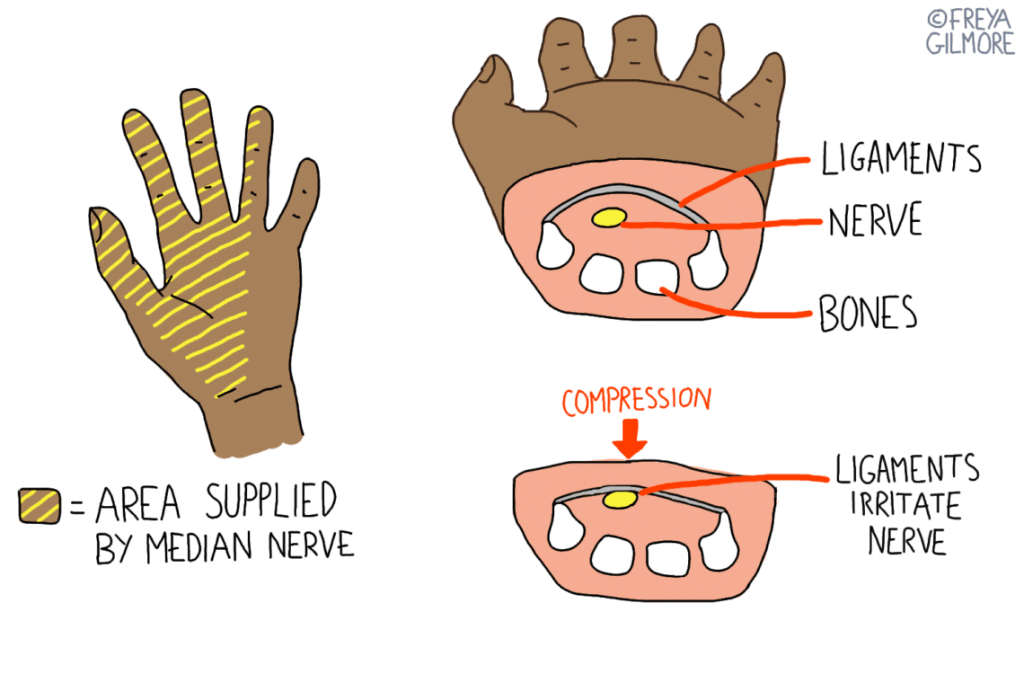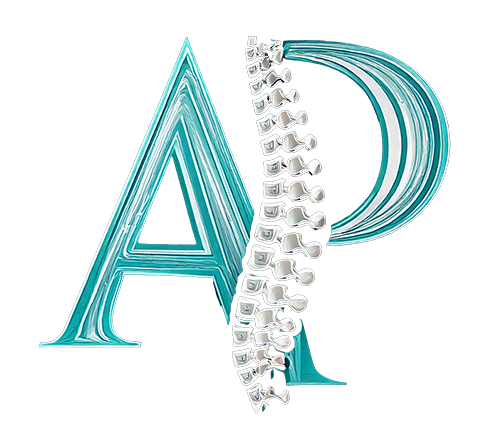Carpal Tunnel Syndrome
The carpal tunnel is a narrow space in the wrist. Nerves and tendons pass through here on their way to or from the hand.

The median nerve runs through the tunnel, and it can be irritated in this small space. This nerve supplies some of the palm with sensation and movement.
When the nerve is irritated, it can cause pain, weakness, numbness, and pins and needles in the area it supplies. These are symptoms of Carpal Tunnel Syndrome (CTS). These symptoms are often worse at night, potentially due to compression of the wrist while sleeping. Bending the wrist is an aggravating factor in itself.
How Carpal Tunnel Syndrome Occurs
The nerve can be irritated in two ways: from pressure from within the tunnel, or from outside.
Internal Pressure
Overuse of the muscles whose tendons run through the tunnel can cause CTS. This is generally agreed to be the most common cause of CTS. Previously known as “repetitive strain injury” or RSI, this can be associated with excessive computer work. The effect on the carpal tunnel is more apparent with poor ergonomics- resting the wrists on a hard desk while typing adds more pressure to the nerve.
Anything that reduces space within the tunnel can predispose CTS. One common factor is fluid retention, as may occur with:
- pregnancy
- kidney disease
- heart failure
- some medications
As cells become more full of fluid, they take up more space and can lead to compression.
External Pressure
Positional problems can cause unnecessary pressure on the nerve from outside the tunnel. One reason that symptoms may be worse overnight is that we commonly sleep with a flexed wrist. This causes compression through the tunnel, and can encourage symptoms to develop overnight.
As discussed previously, direct pressure to the wrist at work will also apply external pressure.
Persistent Symptoms of Carpal Tunnel Syndrome
Occasionally we see patients who still have symptoms after CT release surgery. This is a procedure to make space in the tunnel by cutting the band of tissue near the surface. Persistent symptoms tell us that either there is something in the wrist that continues to cause irritation, or it’s not the wrist at all.
The median nerve can also be irritated further up the arm, causing similar symptoms but having nothing to do with the wrist. One of the muscles that turns the hand over is another point at which the nerve can be compressed. Alternatively, other nerves could be irritated as far up as the neck, causing discomfort, weakness, or numbness into the hand. However, this latter alternative is unlikely to mimic CTS so closely.
Persistent symptoms without surgery do not necessarily mean that surgery is the answer. As overuse of the wrist muscles is considered the most likely cause on average, it makes sense that symptoms may remain as long as the wrist is overused. Your osteopath may be able to help here.
Treatment
Osteopathy is built on the principle that the body can heal itself. As mentioned above, this may be as simple as changing a movement to remove an aggravating factor. Whether this means strengthening one muscle group to take the load off another, or advising the use of a splint overnight,
In the case of wearing a splint, it may be possible to work on other factors at play in order to avoid reliance. Advice such as using ice, or self massage to reduce the impact of overstrained muscles can help here. Techniques from the treatment room that may be adapted for exercise at home could include gentle “flushing” techniques. These aim to reduce any inflammation or fluid build up in the wrist.
For help managing symptoms of carpal tunnel syndrome, book now.

